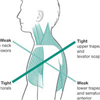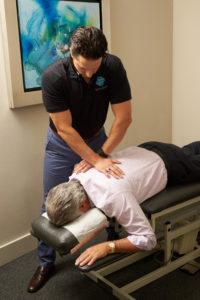Your posture plays an important role in your overall health. Poor posture leads to chronic strain and discomfort. “Upper crossed syndrome” describes poor posture that results from excessive tightness in your shoulders and chest with weakness in your neck and mid-back. This combination forces your shoulders to roll inward and your head to project forward.
 To help understand how upper crossed syndrome causes trouble, think of your spine as a telephone pole and your head as a bowling ball that sits on top. When the bowling ball is positioned directly over the top of the post forward and the ball begins to roll over the edge of the post, significantly more effort would be required from the muscles trying to hold it there. This effort results in chronic strain of the muscles of your neck and upper back.
To help understand how upper crossed syndrome causes trouble, think of your spine as a telephone pole and your head as a bowling ball that sits on top. When the bowling ball is positioned directly over the top of the post forward and the ball begins to roll over the edge of the post, significantly more effort would be required from the muscles trying to hold it there. This effort results in chronic strain of the muscles of your neck and upper back.
The chonic strain is uncomfortable and may also lead to neck pain, upper back pain, headaches, TMJ pain and ultimately- arthritis. This postural problem is exceptionally common in computer workstation users. Correction of this problem is accomplished by stretching the tight muscles, strengthening weak muscles and modifying your workstation.
Upper crossed syndrome is often sets up a more serious condition.
Things We Do to Help
Therapy Modalities
We may apply electrotherapy modalities that produce light electrical pulses transmitted through electrodes placed over your specific sites of concern. These comfortable modalities work to decrease your pain, limit inflammation and ease muscle spasm. Hot or cold packs are often used in conjuction, to enhance the effect of these modalities. Another available option is therapuetic ultrasound. Ultrasound pushes sound vibrations into tissues. When these vibrations reach your deep tissues, heat develops and unwanted wast products are dispersed.
Myofascial Release
Overoworked muscles often become tight and develop knots or “trigger points”. Chronic tightness produces inflammation and swelling that ultimately leads to the formation of “adhesions” between tissues. Your chiropractor will apply pressure with their hands, or with specialized tools, in order to release muscle tightness and soft-tissue adhesions. This will help to improve your circulation, relieve pain and restore flexibility. We often utilize Active Release Technique ( ART ).
Joint Manipulation
Our doctor(s) has found joints in your body that are not moving freely. This can cause tightness, discomfort, poor function and can accelerate unwanted degeneration i.e. arthritis. Your chiropractor will apply a gentle force with their hands, or with hand held instruments, in order to restore motion to any “restricted” joints. Sometimes a specialized table will be used to assist with these safe and effective
“adjustments”. Joint manipulation improves flexibility, relieves pain and helps maintain healthy joints.
Traction
Your condition is aggravated by compression of your spinal joints and discs. We may perform traction “by hand” or utilize a specialized traction table to “decompress” these tissues. Traction helps to stretch your tight muscles and ligaments, improve nutrition to the discs and increases available space in the openings where your spinal nerves exit.
Therapeutic Exercise
Muscle tightness, muscle weakness, or joint mobility restrictions cause discomfort and alters normal joint function, leading to additional problems. Your chiropractor will target tight or weak muscles and mobility issues with specific therapeutic exercises to help increase tissue flexibility, build strength, ease pain, and mover better. Healthy movement, strong, and flexible muscles may help prevent re-injury.
Things you Can Do To Help Yourself
Workstation Ergonomics
Ergonomics is the science of adjusting your workstation to minimize strain in the following ways:
• Maintain proper body position and alignment while sitting at your desk – Hips, knees and elbows at 90 degrees, shoulders relaxed, feet flat on floor or footrest.
• Wrists should not be bent while at the keyboard. Forearms and wrists should not be leaning on a hard edge.
• Use audio equipment that keeps you from bending your neck (i.e., Bluetooth, speakerphones, headsets).
• Monitors should be visible without leaning or straining and the top line of type should be 15 degrees below eye level.
• Use a lumbar roll for lower back support.
• Avoid sitting on anything that would create an imbalance or uneven pressure (like your wallet).
• Take a 10-second break every 20 minutes: Micro activities include: standing, walking, or moving your head in a “plus sign” fashion.
• Periodically, perform the “Brugger relief position” -Position your body at the chair’s edge, feet pointed outward. Weight should be on your legs and your abdomen should be relaxed. Tilt your pelvis forward, lift your sternum, arch your back, drop your arms, and roll out your palms while squeezing your shoulders together. Take a few deep cleansing breaths.
Pillow Selection
To avoid neck and upper back pain from improper neck support:
• Select a pillow that will hold your head in a neutral position(no excessive bending upward/backward of the head) while sleeping on your side or back.
• Avoid excessively thick or multiple pillows.
• Choose a fiberfill or feather/down pillow as these are usually better than foam.
• Consider a commercially available pillow that promotes good neck posture.
Exercises for Home
Your chiropractor will also provide exercises specifically selected to assist with your recovery and help minimize future problems. These exercises should be performed slowly and within a relatively comfortable range. Maintain good posture and breathe naturally. Do not hold your breath. Unless otherwise instructed, stop any exercises that cause pain, or radiating symptoms.
If this is a condition that you would like more information on please do not hesitate to contact our office, Simon Spine.

